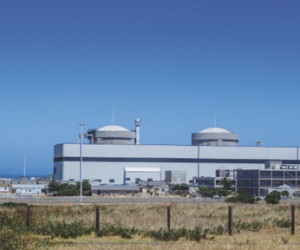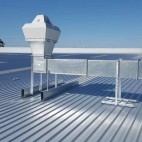To understand the nuclear side of the argument, I chatted to knowledgeable Francis Carruthers, CEO of Lesedi Nuclear Services, who is playing a pivotal role in power generation and has a passion for the nuclear industry and localisation.
Lesedi Nuclear Services evolved from Intens Engineering, which was founded soon after the construction and commissioning of South Africa´s Koeberg Nuclear Power Station by AREVA (global leader in design and construction of nuclear power plants) in the mid 1980´s. The company was founded to provide engineering, recurrent maintenance services and technical resources for the South African nuclear power industry.
The evolution of the Koeberg Power Station, it’s probably at least 30 years old now, maintaining that, keeping it going all these years, what are some of the challenges?
Well you’re right, since 1984, as you can see in one of these pictures there, depicting the team during that time. When I started the business I offered project management services and got involved in assisting them with fine-tuning the plant in the early stages. There were some things they had to sort out, and obviously there were various different recommendations that came from the IAEA or from the licensing aspects, to improve the operation of Koeberg. Some modifications were completed and we got involved in those, as well as the refuelling activities that Lesedi looked after, and we have been doing so since then. We looked after most of the refuelling activities on the nuclear island, which means looking at opening and closing various different vessels, doing the refuelling of the reactor, valve and pump maintenance and things like that.
And a very good safety record to date, what do you put that down to?
Well I live in Melkbos which is right next door to the power station so I’m very keen to make sure that it’s in a very safe condition when it gets returned to service. The skill levels that we’ve developed on the maintenance side of it—I’m very proud of that track record and the culture of safety that we’ve built up to be able to operate. Not so much the operation—that’s been left to Eskom—but mainly the maintenance activities, that is where we’ve been involved with Eskom. We feel that we’re part of the Eskom team in the management of Koeberg.
And the life cycle of the plant, how many more years would you expect to get out of it?
It was originally designed for 40 years, but if you look after something very well you can do some life extension. Nuclear energy is going through quite a big evaluation, particularly the operation of these plants and certainly you can almost double it to probably 80 but at the moment they’re looking at taking it from 40 to 60 years. So in another ten year’s time the plant would have done its 40 years and we’re going to have a life extension to 20, which means that they do have to replace some components and obviously there is obsolescence. The plant was designed and a lot of the equipment was procured in the late 70’s, so there’s quite a bit of obsolescence, which should keep our teams busy re-engineering some of the parts.
And how much of that engineering is done in South Africa?
We’re very much focused on localisation, and working with Areva, we maximise as much as possible. Obviously some things we can’t do and there are some components that we have to procure from France, so it’s a joint effort between ourselves and our shareholder, Areva.
The big talk at this time is the new proposed nuclear power stations, what effect would that have on Koeberg?
Koeberg has only got two units and so the more units around the better the skill levels will be—you can then maintain the resources between refuelling, for example. At the moment we’re retaining some of the maintenance activities by working in America, the UK, France, Brazil and other places to retain our expertise. We intend to build up a bigger base of skilled professionals to work on more units at the same time, so that’s one aspect. We also intend to become very much more self-sufficient in the engineering aspect. At the moment, because we’ve only got these two units, we’ve also got the threat of other nuclear power stations being built in the world where some of those resources can be tempted away by large packages, so as we get bigger we should try to build a more sustainable base of nuclear engineering knowledge in South Africa.
Do we have to outsource this or would we able to do it all in-house?
For the new build we will definitely rely on outsourcing, depending on who is chosen as the bidder and whether it’s the Russians, Koreans, French or Japanese. Whoever it is, we will definitely have to rely heavily on them to start with.
What are your general views of this deal?
Debating among my peers in the nuclear business they also feel that maybe the Russians could have a bad perception because of the insinuations that have been going on between Putin and Zuma. However, they may be the best option and they may be the cheapest option and they may have the best technology but obviously they’re going to have the stigma of the political shenanigans that’s been going on elsewhere. We need to get on with the nuclear build and as soon as possible. There are a number of coal fire power stations that are going to be de-commissioned very soon, and that’s going to create a lot of unemployment, so we need to create more employment through another alternative power generation technology.
In terms of how many of these plants we need – are we building too many or will there be a demand for them?
Well, we’re sitting at junk status at the moment and the country is not growing as fast as we expected. We wanted some decent growth over the last two or three years of 3 or 4 or maybe even 5%, which would be normal for a developing country like South Africa. Unfortunately, because that hasn’t happened the demand for electricity has decreased, so we’re sitting in a situation where we don’t really need the power today, but obviously our projection is that we will need it in the future. It’s a case of when do you start actually building, and the problem is if you start building too late you’re not really taking advantage. There’s some competitive pricing out there at the moment and the nuclear industry is hungry for new projects, so we should be able to negotiate some quite good deals if we start now. If we wait until everybody else is picking up then we may not be able to get the same commercial deals.
And globally, the uptick of nuclear in terms of procurement?
Very much so, actually a large number of African countries are becoming much more interested in nuclear, I know that Kenya and Tanzania are setting up something and Nigeria has been looking at it. There are a number of African countries, apart from some of the North African countries, that have already looked at nuclear. It’s a very important part of the energy mix in a country – you can’t just rely on, for example in Kenya on GSL and you can’t rely on coal for South Africa because we have a water issue here.
We need to build some power stations at the coast where there’s no coal, so now do you take coal down to the coast or is it better we build a nuclear power station at the coast using the cold water? This could be quite efficient, so it is quite imperative to have a very good energy mix in the country. As you can see Abu Dhabi has got plenty of oil, yet they’re building nuclear, Saudi Arabia is going to start building nuclear and Iran’s part of a nuclear programme. They’ve all got access to a certain amount of oil and gas, so you can see it is an important component of the power generation mix.
And where would the key locations be that would be best suited to setting this up?
Well, around the coast and obviously the colder the water the better because it increases the efficiency of the secondary side of the plant. I know that the first nuclear units will probably be close to St Francis Bay, Humansdorp area, and they’ve done some seismic analysis down there, which is also important from a power plant point of view. Possibly some more units down at Koeberg, on the Koeberg side, but there are other sites that have been targeted around the coast.
And if coal is on the way out, just how long is it going to take for that to take a back seat?
It should take seven years to build, from the start of a nuclear new-build programme to the first unit generating. Some of the coal-fired power stations really are reaching the end of their life so some of them are looking at five years, some at ten years. They are going to have to come off the grid because otherwise it’s going to be far too expensive to maintain them, so it’s that sort of cross-over point.
Is it possible to make nuclear cleaner and safer, as we move forward with new designs?
What’s quite important is that nuclear is a little bit like the aircraft industry, you don’t want to tinker with it too much, once you’ve developed it, tested it and it works, let it do that. I don’t know if we should move too quickly, and especially in South Africa, we should really be replicating something that’s already working.
It’s almost like a Japanese way of looking at cars; they don’t tinker too much and keep a reliable design?
And specially for Africa, let’s keep it simple and let’s have the power where it’s needed. Build around the coast, balance the power from that and lay a good base, and yes we also need renewables in the mix, even though they may be relatively expensive. It’s part of South Africa’s moral obligation to Africa that we consider that we are the biggest producer of power on the African continent, that we are sensitive to emissions and look at taking the lead on the renewables.










